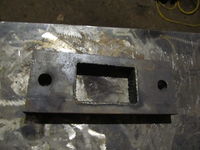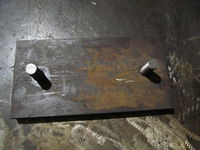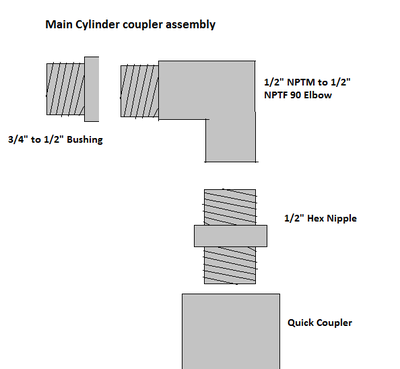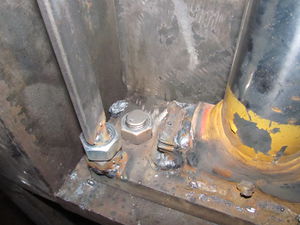CEB Press/Manufacturing Instructions/Main Cylinder Preparation
| |||||||||||||||||||||||||
![]() Warning: The documentation for the CEB Press is undergoing a thorough overhaul. CAD models and written directions are presently obsolete. For more information, see Talk:CEB_Press#Documentation_overhaul_in_progress. When the models, specifications and text on this article have been thoroughly reviewed, updated when necessary, and confirmed as whole and accurate, this warning may be removed.
Warning: The documentation for the CEB Press is undergoing a thorough overhaul. CAD models and written directions are presently obsolete. For more information, see Talk:CEB_Press#Documentation_overhaul_in_progress. When the models, specifications and text on this article have been thoroughly reviewed, updated when necessary, and confirmed as whole and accurate, this warning may be removed.
Before you can start assembling the main frame, you need to prepare the main cylinder by attaching the press feet to it.
Tools Required
- Welder
- Torch
- Mag-Drill with 13/16" bit
- Angle Grinder
- Big square
- Speed square
Materials Required
Hydraulics
Note: NPT means national pipe thread, and refers to the interior diameter of the hoses. NPTM means a male end, and NPTF means a female end.
- Thread Tape
- 5”x12” 3000 PSI Hydraulic cylinder Buy (1)(This is for the super CEB.)
- 5"x8" 3000 PSI Hydraulic cylinder (1) (This is for the normal CEB)Buy
- 3/4" to 1/2" NPT Bushing (2)Buy
- 1/2" NPTM to 1/2" NPTF 90 Elbow (2) Buy
Note: the following are optional and to be used only in fabrication. It is highly suggested you use them. It enables the cylinder to be easily expanded without having to hardwire it to a pump.
- Set of 1/2" Quick couplers (1 male and 1 female)
- 1/2" NPT Hex Nipple (2) Buy
Steel
- 1 1/2” DOM Roundstock: 3.5"; Press Foot Filler (1)
- 1”x4” Plate: 10"; Lower Press Foot (1)
- 1”x6” Plate: 12"; Upper Press Foot (1)
Nuts and Bolts
- 3/4" Steel Nut (1)
- 3/4" Threaded Rod: 5" total; Upper Press Foot- 2.5" (2)
Diagrams
The lower press foot:
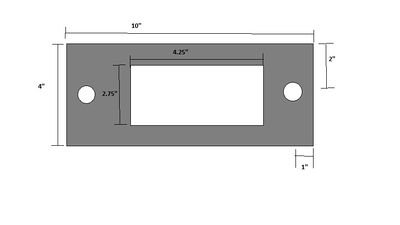 WTF? Why is this non-symmetric?
WTF? Why is this non-symmetric?
The upper press foot:
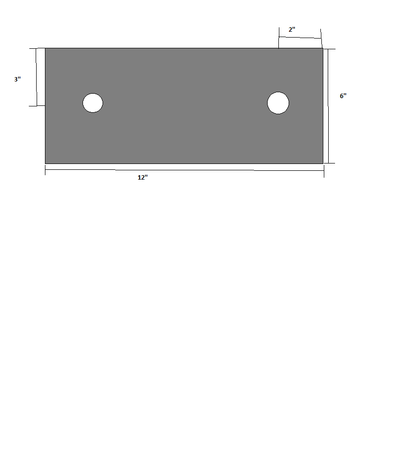
Fabrication Instructions
Prepare the press feet
- Mark and magdrill 13/16" holes in 1"x4"x10" plate for the lower press foot. They should be centered shortways, and 1" from the edge to the center of the holes long ways. See the diagram in the diagrams section.
- Place this centered on the 1"x6"x12" upper press plate and transfer punch the hole locations. Mag-drill these holes, again 13/16".
- Torch out a 4 1/4" x 2 3/4" rectangular hole in the lower press plate. Grind it smooth.
- Cut two 2.5" pieces of 3/4" threaded rod.
![]() Warning: The upper press foot NEEDS to be 12" across at the top of it (the side without the bolts sticking up) or there will be "fuzzy edges" on your bricks. See the quality control section on this page for more info.
Warning: The upper press foot NEEDS to be 12" across at the top of it (the side without the bolts sticking up) or there will be "fuzzy edges" on your bricks. See the quality control section on this page for more info.
- Plug weld the threaded rod into the upper press plate, so that the threaded rod is about 1/4" deep in the plate. Fill the hole with weld, then grind it flush.
Prepare the coupler assembly
You will need to put a hose between the two ports to expand it so you can weld it. It is highly suggested you use quick couplers although you can "hardwire" the cylinder to a pump for later steps. These instructions assume you use quick couplers.
- Thread tape is necessary between each connection unless otherwise stated.
- Always wrap thread tape clockwise when facing the threaded portion.
- You will need to make 2 of these, one with male quick couplers and one with a female.
- Put the hex nipple in the vise and tighten the quick coupler onto it.
- Put the elbow in the vise, male side up, and tighten the bushing onto it.
- Rotate the elbow in the vise and tighten the quick coupler/ nipple onto it.
Attach coupler assembly to cylinder
- Remove the plugs.
- The Prince brand cylinder uses a really large allen wrench for their plugs. If you can't find one, you can make one like we did. media:allentool.jpg
- Make sure the ports are facing up as there might be fluid in the cylinder and you don't want it to leak.
- Tighten the coupler assembly into the holes, so that when the cylinder is rolled sideways, niether one will hit the table.
Attach press feet to the cylinder
- Expand the cylinder so the shaft is fully extended, using a hydraulic pump. (If you chose not to use quick couplers, you can attach a hose between ports and pull.)
- Weld a 3.5" piece of 1.5" DOM roundstock inside of the tubing at the end of the shaft.
![]() Warning: Take care that the top of the shaft doesn't get hot; there is a rubber seal between that and the cylinder that will melt and cause leaking if you're not careful. If it starts getting warm, dunk the shaft in water to cool it down.
Warning: Take care that the top of the shaft doesn't get hot; there is a rubber seal between that and the cylinder that will melt and cause leaking if you're not careful. If it starts getting warm, dunk the shaft in water to cool it down.
- Stand the cylinder up vertically and support it using some sort of rope so it is as close to square vertically as possible. Another option is to prop it up using some sort of solid stand. .
- Place the tubing at the end of the shaft inside of the hole in the lower press foot.
- Insure the cylinder is square to the plate in all directions. See video.
- Tack the lower press foot from all dimensions.
- Insure the cylinder is still square with it, if not, remove the tacks and fix it.
- Weld the two together on the top. There will need to be at least 2 layers of weld.
- Gather some press foot support pieces. We used scrap 1" plate torchings, but anything close to a 1"x1"x2.5" piece will do.
- Weld these as close as you can to the tubing and the press plate
- Lower the hanging cylinder and flip it upside down.
- Fill in the bottom side of it with welds. This will require many layers of welds and many dunks to cool it.
- Grind it flush with the rest of the plate. A few spots where the welds are below the surface is OK, but the majority of the surface should be level.
- Put the upper press foot into the lower one and tighten nuts onto the threaded rod.
- Stand the cylinder up again and insure the press plate is still square with the cylinder. See video
- If its not, you'll need to add shims between the two press plates until they are square with the cylinder.
Weld the magnet holder nut in place
- Weld the nut in the corner of the lower press plate, as shown. This should be on the opposite side of the ports of the cylinder, flush with the press foot, and as near to the corner as you can get it. It can even hang off a bit. Make sure you protect the threads.
Quality Control
- The press foot must fit tightly within the compression chamber. Otherwise, the corners of bricks will not be clean as soil escapes from the compression chamber.
- The compression chamber side spacers need to be even with the other sides of the chamber
- Main cylinder adjusters cannot push against the cylinder in their native position. They are used to adjust the cylinder by the action of the bolt.
- Here is a discussion:

